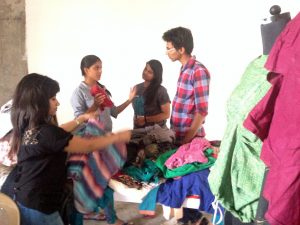
Surviving the Future workshop, 2015
Surviving the Future was a four-day design workshop in which teams of fashion students were challenged to address systemic waste and exploitation within the garment industry. As globalization changes the conditions of life and work how can fashion become part of a long-term strategy for survival? The apparel market is valued at $1.7 trillion and employs approximately 75 million people.(1) Can a change in our daily practice, whether in production or consumption, have a significant affect on the planet?
The approach was to investigate the lives of precarious workers in garment industry through a look at the life-cycle, production, and consumption, of a single cotton t-shirt. From the farm workers, toxic chemicals, and large quantities of water needed to grow the cotton, to the transportation workers’ living conditions and fossil fuel consumption, to the labor exploitation, unhealthy working environment and water pollution associated with the weaving and dying of the fabric, to the exponential growth of fast, disposable fashion which pressures the system into production speed ups, 12-15 hour work days, harsh treatment, and unsafe sweatshops, to the precarious conditions and exploitation in the modeling and advertising industry, to retail workers with uncertain hours, living below the poverty level despite working full-time, without benefits, to unsustainable amount of clothing waste ending up in landfills where it pollutes the earth.
According to a study published in 2009, the material, production, and transport of one t-shirt weighing approximately 6 ounces produced in India uses: 700 gallons of water, .22 pounds of fertilizers, .01 pounds of pesticides and 1.2 pounds of fossil fuel. People work in abhorrent conditions to give us clothes that we can crumple up and throw in a pile in our closet.(2)
The case was made for creating a uni-garment for the precarious worker. One outfit that would reduce both unreasonable demands on production and stem unsustainable consumption. An outfit to create a sense of unity among the individual workers that often have short-term contracts and shift between workplaces every few months making it hard to form long-term relationships and alliances needed to organize for labor reform.
The participants were challenged to design for surviving the future by creating one outfit that addressed some of the ideas discussed in the workshop. It was proposed that we recycle used clothing, as there are estimates that we have about 26.7 billion items of unused clothing in the world.(3) It was also discussed that if we were to have only one outfit it would be good to have items of clothing that could serve several purposes. One prototype made by students for a precarious worker uniform is an apron made of clothing remnants gathered from the floor of a tailoring shop. The scraps of fabric carry the invisible imprints of the workers hands, each scrap represents their hours of wage labor. This apron is a link between their work and the bodies and labor of precarious workers everywhere.
The participants were inspired by unused clothing to created prototypes for clothing that can be converted into different forms:
The discussions that followed the workshop included a number of proposals:
- Mock up of designs for precarious worker uniform on denim, the workers fabric.
- A “collective closet” in which members of a community could share clothes.
- Clothes that grow out of organic material and create a second skin.
- A uniform that would respond to the working conditions of the factory- for example that could have convertible legs, so that the workers would be able to sit down while on the assembly line.
1. FashionUnited.com
2. The Lifecycle of a T-Shirt by Mattias Wallander
3. blog.cladwell.com, Fast Fashion is Ruining the World
Work produced during the residency “Precarious Body and Work” at SIDE, March 2015.